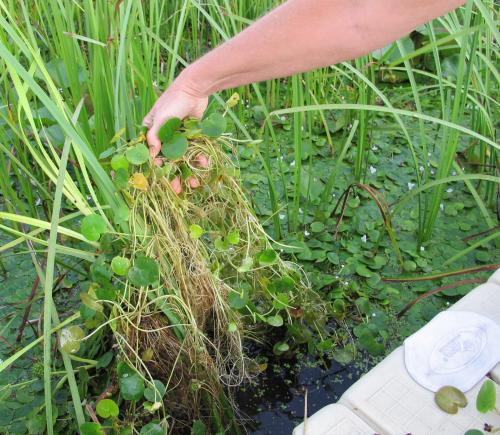Do not release invasive species: Part 1
When managing water features, contractors and water gardeners can prevent the introduction of Aquatic Invasive Species into natural waterways by using proper disposal methods.
Managing a water feature can sometimes mean tough decisions about excess or unwanted aquatic plants and animals. Plants can reproduce and outgrow the feature, as can fish, frogs and snails. There may be temptation to release plants or animals into a ditch, drain, pond or into a natural waterway. As many popular water feature plants and animals are not native to Michigan waters and even appear on the state’s list of Prohibited Species, it is important to responsibly dispose of these organisms. Releasing any aquatic organism into the environment is not an accepted practice and may even be punishable by law.
When non-native plants or animals are introduced into waterways they can become invasive due to an absence of natural controls (predators, disease, climate, etc.) that would normally keep them in check. Exotic non-native plants and animals have proven over and over again their ability to adapt to colder environments and water temperatures. These non-native invaders of our waterways are called Aquatic Invasive Species (AIS). They not only negatively impact the aquatic environment; they create negative recreational and economic impacts for individuals, businesses and communities.
A case in point is last summer’s discovery of European Frog-bit (Hydrocharis morsus-ranae) in the City of Alpena’s Wildlife Sanctuary – a beautiful 500-acre coastal wetland preserve adjacent to Lake
Photo caption: A popular water gardening plant, European Frog-bit has escaped and invaded Alpena’s coastal wetland preserve and the Thunder Bay River watershed. Dense floating mats crowd out native wetland plants. Photo credit: Jane Herbert
As there is no aquatic herbicide proven safe and yet effective in the treatment of E. Frog-bit, the Michigan Department of Natural Resources AIS Early Detection, Rapid Response (EDRR) Unit worked with the city over a two week period to remove by hand over 1,000 pounds of E. Frog-bit from the sanctuary. But according to EDRR Coordinator Matt Ankney, “We barely scratched the surface of the current infestation.” Upon further investigation, the MDNR found E. Frog-bit upstream on the Thunder Bay River as far as Fletcher’s Pond. Large scale removal efforts are being planned for next spring and summer.
What can water gardeners do to help prevent the spread of AIS? For starters, never assume a plant or animal is native to Michigan. Never assume a plant or animal is harmless or benign. Understand that retail names and descriptions of plants and animals can be misleading. Michigan State University Extension and the national Habitattitude Campaign recommend the following options for safe disposal:
- Contact retailer for proper handling advice or for possible returns
- Give/trade with only well-informed water gardeners
- Donate to a local aquarium society, school or aquatic business
- Seal aquatic plants in plastic bags and dispose in trash to be landfilled
- Contact veterinarian or pet retailer for guidance about humane disposal of live animals
Do not release water garden animals and plants into the outdoor environment – even if they appear to be dead. Do not compost these organisms – even if they appear to be dead. Part 2 of this article provides guidance on Michigan’s Prohibited Species list and associated penalties for violation of this law.



 Print
Print Email
Email


